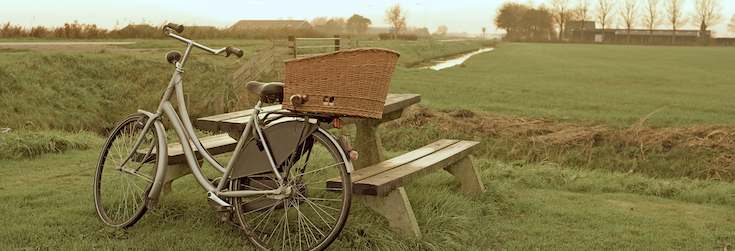The Top 5 Benefits of Cycling
Article Found on Harvard.edu
They say you never forget how to ride a bike, so maybe it’s time to climb aboard a two- or three-wheeler and enjoy the health benefits of cycling. “It’s socially oriented, it’s fun, and it gets you outside and exercising,” says Dr. Clare Safran-Norton, a physical therapist at Harvard-affiliated Brigham and Women’s Hospital.
Check out the main physical benefits.
1. It’s easy on the joints. When you sit on a bike, you put your weight on a pair of bones in the pelvis called the ischial tuberosities, unlike walking, when you put your weight on your legs. “That makes it good for anyone with joint pain or age-related stiffness,” says Dr. Safran-Norton.
2. Pushing pedals provides an aerobic workout. That’s great for your heart, brain, and blood vessels. Aerobic exercise also triggers the release of endorphins, the body’s feel-good chemicals—which may make you feel young at heart.
3. Cycling builds muscle. In the power phase of pedaling (the downstroke), you use the gluteus muscles in the buttocks, the quadriceps in the thighs, and the gastrocnemius and soleus muscles in the calves. In the recovery phase (backstroke, up-stroke, and overstroke), you use the hamstrings in the back of the thighs and the flexor muscles in the front of the hips.
Cycling works other muscles, too. You use abdominal muscles to balance and stay upright, and you use your arm and shoulder muscles to hold the handlebars and steer.
4. It helps with everyday activities. “The benefits carry over to balance, walking, standing, endurance, and stair climbing,” says Dr. Safran-Norton.
5. Pedaling builds bone. “Resistance activities, such as pushing pedals, pull on the muscles, and then the muscles pull on the bone, which increases bone density,” says Dr. Safran-Norton.
Safety considerations
Get the okay from your doctor before you climb aboard a bike, especially if you have heart disease, arthritis, or thinning bones. “If you have osteoporosis, consider riding a tricycle, which is more stable than a two-wheeler, posing less of a fall risk,” says Dr. Safran-Norton. “Don’t ride a bike at all if you’ve had a recent fracture. Another fall could make it worse.”
When riding, remember that the seat height should allow a slight bend at your knee. “You don’t want a straight knee at the bottom of the pedal stroke, because the bike could be too tall and you could fall off,” says Dr. Safran-Norton.
Other tips: Wear a helmet to protect your head; don’t use clips to keep your feet on the pedals, which can make injuries worse if you fall; don’t ride alone; stick to bike paths instead of riding in the street; stay hydrated before, during, and after your ride; and use sunscreen and sunglasses.
You probably know that a helmet is a must for safety. The right type of clothes and bike will also make cycling safer and more comfortable.
Cycling clothes. These have high-tech fibers that wick away moisture. They are usually neon-colored, with reflective material so you’ll be visible to drivers. Bike shorts have a thick pad or chamois to prevent chafing and provide cushioning.
Bikes. Look for one that puts less stress on your body, such as a beach cruiser or comfort bike. They have high-rise handlebars that enable you to sit upright, wide tires for a smooth ride, shock-absorbing seat posts, and low top tubes so you don’t have to swing your leg too high to mount the bike (allow at least an inch or two of clearance between you and the tube). If mounting a bike is difficult, there are even “step through” bicycles that feature top tubes just six inches off the ground (see photo).
Other bike types include tricycles, which are helpful if you are less stable on your feet, and recumbent bikes that allow you to lean back and ride. “If you have spinal stenosis, a recumbent bike puts your spine in a flexed position and gives you pain relief. But if you have a herniated disk, the bike can make the disk bulge more,” says Dr. Clare Safran-Norton, a physical therapist at Harvard-affiliated Brigham and Women’s Hospital.
Saddle. Get one with extra padding that’s wide enough to support the pair of bones you sit on. Go even further with a saddle that relieves pressure on the perineum, the area between those bones, behind the genitals. It’s home to nerves and arteries that supply the lower body, and too much pressure here may cause numbness and tingling in the legs. Pressure-relieving saddles may have a “noseless” or horseshoe design.
Grounded in the belief we are all unique beings, we begin each new client with a meticulous bio-mechanical evaluation, assessing each joint in its relationship to the movement of the body as a whole. Our therapists are skilled at reading the unique story your body tells, and treating everything from the bottom of your foot to the top of your head.
Bodywise Physical Therapy is located in Portland, Oregon. The Bodywise approach is wholistic, individualized, and can benefit people of all fitness levels. While Bodywise has always specialized in general orthopedics, spine rehabilitation, and sports medicine, they have evolved into a truly wholistic practice integrating Hands-on treatments with Mindfulness, Pilates, Trauma Release Exercise, Womens Health and Lymphedema.


